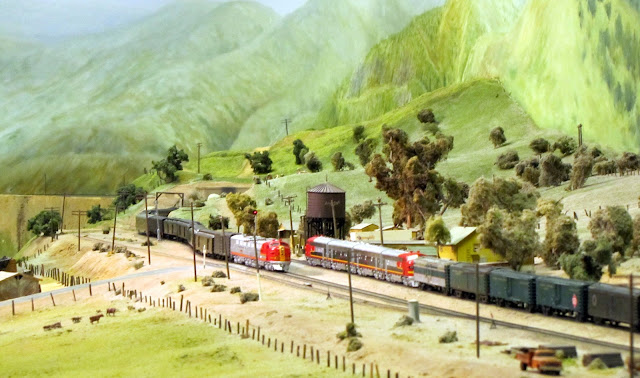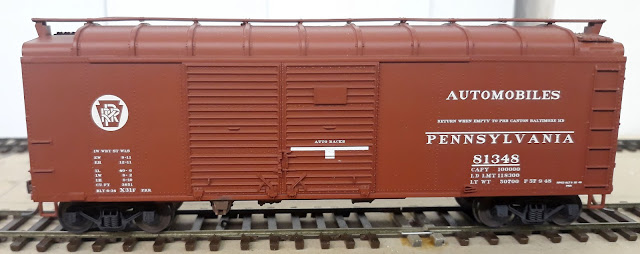Passenger service service express reefers were used for over 50 years to move perishable goods, often fruit and vegetables across the country at high speed, beyond the speed that regular reefer blocks could move. Equipped with 90 MPH steel wheels, signal and steam lines this meant the cars could move in mail trains and special express perishable blocks.
 |
| ATSF No.7 drops into the siding at Bealville meeting ATSF No.4 with a large express reefer block on the head end. |
There was always a shortage of express reefers, pushing the owning railroads to pool their cars into the Railway Express Agency. The REA was comprised of 37 railroads which could lease cars or even partial space within the baggage, express boxcars, or express reefers to move express traffic anywhere in the country regardless of who actually owned the car.
Classic 50ft Wooden Express Reefers (REA & Others)
Athearn
.jpg) |
| Athearn stock model lettering with large 1953 herald removed |
These models date back to at least the 1980s. I believe this example was produced in the 1990s. Like most older mold-base Athearn models, they are shortened to a 50ft body length, which is a couple feet short of the standard express reefers after about 1920.
I did re-truck these Athearn models to 8ft express trucks. Athearn's newer offerings of this body style I believe has these trucks and I was able to buy the trucks to refit my older models, like REX 1256 here.
Walthers
In the early 2000s, Walthers produced a new set of tooling for wood-bodied express reefers.
Railway Express Agency
 |
| Apologies for the poor lighting I don't recall where I was able to get this photo from. This is an early-scheme REA car. Some had reporting marks over both trucks. This might be a BLI car, described in the next section. |
Most cars would have still been in their original REA scheme, which was a more drab color of Pullman green. The most notable thing about this scheme's lettering is the "EXPRESS REFRIGERATOR" low on the carside over each truck.
.jpg) |
| REX 300 - Hunter Green, with removed large herald and corrected reporting marks size |
The Railway Express Agency owned several hundred express reefers in several number series. This is a Walthers model with the large 1953 red and white herald removed to back date the car for pre-1953 scheme.
.jpg) |
| REX 1417 (Stock Walthers version) |
The REA introduced the large red and white herald to the Hunter Green paint scheme in 1953.
BLI
 |
| This is an early-scheme REA car. Some had reporting marks over both trucks. This might be a BLI car. |
BLI has also produced models very similar to the Walthers models, with 52-53ft length over the body.
Steel Reefers
 |
| REX 6100-series (500 cars) in original 1947 stripped scheme, which didn't last long... |
Branchline-Atlas (1947 Welded)
 |
| Fourth run "Early 1950s" Scheme on 1947-welded express car Branchline kit. |
Unfortunately, over the years, I only found a single Branchline welded kit. Atlas has taken over the tooling from Branchline, and should be offering the steel cars again at some point. They did make the as-delivered silver/green stripe scheme (below), but I wasn't able to snag any of those. So all my stripe-scheme models are slightly incorrect with the riveted body and some small details being from the later cars.
Walthers (1957 Riveted)
.jpg) |
| Walthers fobie of 1947 original REA paint scheme on the riveted 1957 model. |
The Walthers models are actually the 1957 version which was riveted, in a seeming reversal of normal construction techniques of the time. The original striped scheme didn't last long because of the complicated painting work. The strips didn't hold up well when the cars were washed.
 |
| REX 6218 after repainting circa 1950 to the plain Hunter Green scheme without the REA logo |
Within a couple years the REA decided to repaint the steel cars into a new scheme which used the same lettering positions, but with overall Hunter Green and yellow lettering.
.jpg) |
| REX 6318, with large 1953 herald. |
The second scratch-painted Walthers model that I built in the early 2000s has the 1953 herald for some variety.
Brass - Various Manufactures
 |
| SP 4627, an SW8, switches REX 6467, a late-series (1957) express reefer in Bakersfield. |
This is an example of one of the brass all-steel express cars painted up with large herald and incorrect (I believe) white lettering.
PRR R50B
Walthers
%20A2.jpg) |
| Pre-war PRR scheme with moderate weathering. These often had olive colored trucks. |
For my modeling era, I generally try to avoid pre-war paint schemes that would have been repainted by my era of 1948-1953. The pre-war PRR R50B scheme, shown above, has a different style of lettering as one of the main give-aways to its era.
 |
| PRR 2562, an R50B class express reefer, lettered for REA leasing. - Stock decorated model for post-WWII era. |
One of the large suppliers of reefers to REA was the PRR, still providing 358 express reefers in 1953. There's even photos of 25+ of the R50Bs at Los Angeles Union Station, being stored on a back track during the same era. This shows that the R50Bs certainly were on the west coast and available for express perishable loading.
 |
| PRR 2562 after weathering with grime and east-coast soot along the rivet rows and western dust along the lower body and trucks. |
This particular model was weathered with eastern grime/soot and a light splast of western dust along the lower body from high speed travel through the deserts. The chalk marks are for Santa Fe No.24, the Grand Canyon, which would have been a common routing out of the San Joaquin Valley at Bakersfield, via Barstow to the TransCon, to Kansas City or Chicago diversions to the destination.
Operational Notes
The use of express reefers on the west coast is primarily eastward perishable loadings. Westward loads certainly could be perishables, but the express reefers (and even plain SFRD/PFE reefers) could be loaded with publications, such as weekly or monthly magazines and catalogs. The REA leasing express-reefer cars would then have their hatches locked in the down position and used as express boxcars with bags of the published materials hand-loaded through the narrow doors. There was certainly express movements from just about every growing area in the US, but there would be found some load within a few hundred miles to get them off on their next trip.
 |
| A Santa Fe GP7 leads a string of express reefers through Kern Jct. towards early grape loading at Arvin. LMRC layout, TT/TO Session "Jan 8,53" |
In the photo example above, the majority of the provide cars in this train are REX (REA owned) cars with a couple foreign line reefers at the rear end including a GN steel express reefer ahead of the caboose. The GN cars could easily be moving apples, black berries, etc around late in the year and then being loaded out of Southern California to pretty much anywhere in the nation, as REA leased cars didn't have to return to their "owner" at the end of each trip.
In Closing
 |
| Collection of Athearn (top two: REX 427 & PFE X603), and Walthers (PFE 747, DRGW 1604, PFE 706) |
I don't have much more to say in closing. Probably in a few weeks or maybe next month, I'll be uploading Part 2 covering other railroad's express reefers, such as PFE and SFRD. Tony Thompson and several other blogs have done articles on Express Reefers, so I'm putting some of those links below.
Jason Hill







%20REV-A.jpg)

.jpg)

.jpg)
.jpg)


.jpg)

.jpg)

%20A2.jpg)





























